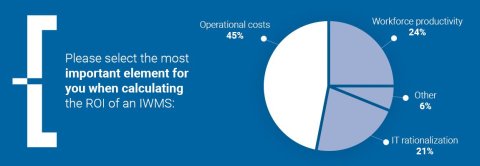
This is part two of a three-part blog series. For this series, I am sharing key take-aways from the recent webinar about the ROI of an IWMS, which was organized by Planon and Verdantix. The webinar is based on the new Verdantix report titled, "The Business Case for Integrated Workplace Management Systems".
This is part two of a three-part blog series. For this series, I am sharing key take-aways from the recent webinar about the ROI of an IWMS, which was organized by Planon and Verdantix. The webinar is based on the new Verdantix report titled, "The Business Case for Integrated Workplace Management Systems". The webinar provided practical tips on calculating the potential ROI of an IWMS and how to write a numbers-driven business case. The first blog was about gaining a better understanding of what an IWMS is and what its key benefits are. For this second blog, I explain how you can create a convincing, numbers-driven business case for the implementation or extension of an IWMS.
Main challenges when calculating the ROI
A global survey by Verdantix has shown that 75% of real estate leaders find their budget insufficient to fund IT investments (Global Real Estate, Energy & Facilities Survey: Budgets, Priorities & Tech Preferences, 2018). To secure budget for a new implementation or extension of existing software, RE and FM professionals need to show that the proposed investment for an IWMS delivers a higher ROI than other projects that are also in the waiting line for funding.
This is easier said than done. We’ve found that calculating the ROI of an IWMS is a universal struggle for most Real Estate and Facility Managers. Verdantix research points to four common challenges when trying to build a successful business case for IWMS:
- Failure to show near-term-savings. It seems quite a challenge for RE & FM professionals to convince the Chief Finance Officer (CFO) that their proposed investment is the best use of cash.
- The lack of good quality data on wasted cost. Without proper insight into current facilities costs and their inefficiencies, RE and FM professionals have an uphill battle to gather accurate data to build a numbers-based view on how an IWMS saves money.
- Facility Directors, who have been tasked with cutting costs in their departments for years, can sometimes struggle to find further cost savings.
- Real estate leaders sometimes face push-back from decision-makers who focus on the short-term. They question the value-add of an integrated platform, and think that problems are best solved more cheaply via point solutions. In the end, as part of a long-term IT strategy, an IWMS investment can save a lot of money and eliminate the need for multiple standalone software systems that cannot integrate properly.
A business case to pitch an IWMS investment
So, how do RE and FM professionals overcome these challenges? The key is creating a relevant and compelling business case to pitch the IWMS investment to key decision makers within the company. There are three important aspects to keep in mind.
First, show the need and urgency of an IWMS investment! Why is it important to act now and implement or extent the IWMS? Answer this by highlighting the risks that are involved if the status quo is maintained. “If we do not invest in an IWMS, we will face the risk of not being compliant with new rules and regulations.” “Also, the existing systems are nearing the end of their technical lifespan, and we do not want a disruption in our service due to outdated systems.”
Second, create a narrative to show how the IWMS can support the organizational goals. Make a compelling story to the Chief Executive Officer (CEO) about how an IWMS can positively impact the business. Mention the positive effects of this investment on the overall strategic objectives of the company. For example, think of positioning the IWMS software investment in line with the CEO’s automation or mobility plans.
Finally, a crucial part of building a successful case is translating the key benefits of an IWMS into numbers. By linking your business case to concrete financial outcomes, you make your case more compelling.
Savings from IT rationalization, workforce productivity and operational costs
In the webinar, Susan Clarke from Verdantix shared areas where you can find the most compelling savings and numbers:
- IT rationalization: Companies are often able to replace 10 to 20 different software licenses with one single platform. Imagine how much money can be saved when the average IT operation cost of maintaining a standalone or legacy system can be up to 20K per year!
- Workforce productivity: An IWMS improves efficiency by automating processes and different administration tasks. It allows your workforce to spend time on other tasks, which could lead to an increase of 20% or more in operational efficiency. An IWMS also reduces duplicate data entry compared to manual input, and drastically decreases reporting time.
- Operational costs: To generate savings at scale, calculate how many operational expenses can be saved. An IWMS can help to save large amounts in space usage and maintenance, which could represent millions in a large firm.
Real estate and facility managers who registered for the Planon/Verdanitx webinar were asked which area of savings was most interesting to them. The survey results indicated that the majority were interested in knowing how an IWMS can contribute to reducing operational costs:

In the webinar, which is now available on demand, Susan Clarke - Principle Analyst at Verdantix - elaborates further on operational costs as one of the three categories for seeing a return on investment. I highly recommend watching it and listening to the insight she shares.
Are you ready?
Hopefully this blog has helped you on your way with writing a convincing business case. Are you looking for more practical examples on the added value of an IWMS? The third and final blog in this series will explore Planon client cases and outline some of the savings that organizations like Gasunie, King’s College London, and Danfoss have achieved with Planon’s IWMS.
Rather not wait until the last blog? You can watch a recording of the entire webinar with Verdantix right now.




















